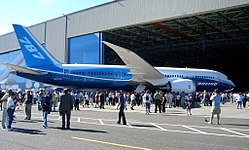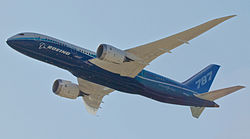Boeing 787 Dreamliner
The Boeing 787 Dreamliner is a passenger aircraft made by Boeing. Its first flight took place on 15 December 2009. It was planned to be released earlier, but the first passenger flight of the airplane was in October 2011. Because of delays some airlines got their aircraft more than two years late.[3]
| Boeing 787 Dreamliner | |
|---|---|
| Boeing 787-8 of All Nippon Airways | |
| Role | Wide-body jet airliner |
| National origin | United States |
| Manufacturer | Boeing Commercial Airplanes |
| First flight | December 15, 2009 |
| Introduction | October 26, 2011 with All Nippon Airways[1] |
| Status | Currently in production; in regular passenger airline service |
| Primary users | All Nippon Airways Japan Airlines Air India Qatar Airways |
| Produced | 2004-present |
| Number built | 1,093 as of October 2023 |
| Unit cost | 787-8: US$ 211.8 million 787-9: US$249.5 million 787-10: US$288.7 million[2] |
The aircraft has had some problems. On January 16, 2013, the Federal Aviation Administration (FAA) said that no 787s were allowed to fly in the U.S. due to batteries catching fire. Several other countries also banned the 787 from flying in their country.[4][5] The problem was fixed and the airplanes returned to flight in April. Already 10 Dreamliners are scrapped.
History
In the late 1990s Boeing wanted to make a plane called the Sonic Cruiser, which would go very fast.[6] But after the September 11, 2001 attacks fuel prices went up, so airlines wanted more efficient planes rather than faster ones. Boeing cancelled the Sonic Cruiser and replaced it in January 2003 with the "7E7," which was the code name for the 787 at the time. In July 2003, Boeing decided to call the new plane the "Dreamliner."
On April 26, 2004, Japanese airline All Nippon Airways became the launch customer for the 7E7, and they expected to have the plane delivered in 2008. In 2005 it was renamed the 787.[7]
The 787 was designed to be much more efficient. It did this by using composite to build most of the plane instead of aluminum, which made the plane lighter.[6] It also used two new engine types, the General Electric GEnx and the Rolls-Royce Trent 1000. According to Boeing, the 787 consumes 20% less fuel than the similarly-sized 767.[8]
In December 2006 Boeing said that the 787 was heavier than they expected, so the plane was delayed.[9] Also, Boeing had tried to shorten the time to make the plane by asking parts suppliers to assemble parts of the plane. These parts manufacturers were not used to the extra work though, and this delayed the 787 even more.
Boeing started to test the 787 on the ground. They found more problems and the plane was delayed even more. Finally on December 15, 2009 the 787 went on its first flight. Boeing began testing the plane in the air. There were more problems, like a failure of one of the Rolls-Royce Trent 1000 engines, and an in flight fire, which delayed the plane even more. Some airlines wanted to be paid back for all the delays.[10] Finally in July 2011, Boeing delivered their first 787 to ANA.
Features
The Boeing 787 has a common type rating as the Boeing 777, which means that a pilot who trains in one of the planes can easily switch to the other with very little additional training.
One of the most interesting features of the 787 is the sawtooth pattern at the back of the engine. According to Boeing this makes the plane quieter for people on the plane and on the ground. The engines also have sound absorbing material at the front of the engine to make the plane even quieter.
The inside of the 787 is the most noticeable feature. The windows are much bigger on the 787 than on other planes because the plane is made mostly of composite, which is stronger than the aluminum which is used on most other planes. Also, the windows of the plane don't use slide-down shades like most planes. Instead they have buttons which can make the window darker or lighter. The inside of the plane also uses LED lighting. This lets the plane change the colors of the lights inside.
The fact that the plane is made of composites instead of aluminum makes the passengers more comfortable. Most passenger planes fly so high that they need to pump air into the cabin so the passengers can breathe. Most planes pump in enough air so that the passengers feel like they are at about 8000 feet (2400 meters). But since the 787 uses composites, which are stronger than aluminum, the plane can pump in more air so the passengers feel like they are at about 6000 feet (1800 meters). The composite is also less vulnerable to corrosion, so the plane can have a higher humidity than most other planes. Boeing says that these improvements will make passengers feel better after a long flight.
Incidents and Accidents
On 12 June 2025 Air India Flight 171 operating the flight from Ahmedabad Airport in India to London Gatwick Airport in United Kingdom crashed shortly after takeoff killing all 12 crew members and 229 out of 230 passengers on board making it the first fatal accident involving a Boeing 787.
Variants
Boeing makes 3 variants of the Dreamliner: the 787-8, the 787-9, and the 787-10. The 787-10 is in testing. They were also going to make the 787-3, but it was later cancelled due to low airline demand.
787-8
The -8 is the shortest 787 variant, flying 210 people about 15200 km. It started flying in 2011. The -8 will replace the Boeing 767-200ER and Boeing 767-300ER aircraft. It is meant for very long trips with fewer passengers, where a bigger plane will not make enough money for the airline.
787-9
The -9 is a larger 787 and has a range of about 15750 km. It can fly about 270 people and started production in 2014. It can carry more weight than the -8, and is longer than the -8. It competes against the Airbus A330-300 and A330-200 aircraft. It will replace the Boeing 767-400ER.
787-10
The -10 is larger than both the 787-8 and the 787-9. It will carry about 300 people, but to do that it will have less range. It will compete with the Airbus A350, and it will also replace the Boeing 777-200ER aircraft.
787-3 (Cancelled)
The -3 was going to be the smallest and would have the shortest range at about 5000 km, and would fly about 290 people. It would have flown only domestic flights. It was only ordered by two Japanese airlines. At first these Japanese airlines had ordered the 787-3, but since the plane was late the airlines cancelled their orders. This made Boeing scrap the 787-3.
Boeing 787 Dreamliner Media
The prototype Boeing 787 underwent taxi tests at Paine Field in November and December 2009.
A 787 at the 2010 Farnborough Airshow
The 787-3 would feature a reduced wingspan with wingtip devices
A defunct subsidiary of Norwegian Air Shuttle, Norwegian Long Haul operated the 787 as a long-haul low-cost carrier.
References
- ↑ "Boeing: About the 787 Family." Boeing. Retrieved February 26, 2014.
- ↑ "Boeing: Jet prices." Boeing. Retrieved February 26, 2014.
- ↑ Boeing sees first 787 cancellation, lags Airbus. 7 August 2008. https://www.reuters.com/article/boeing-orders-idUSN0732640420080807.
- ↑ Boeing 787 'Dreamliner' jets grounded in Japan, US. http://www.scmp.com/news/hong-kong/article/1130043/boeing-787-dreamliner-jets-grounded-japan-us.[dead link]
- ↑ DGCA directs Air India to ground all six Boeing Dreamliners on safety concerns. January 17, 2013. http://economictimes.indiatimes.com/news/news-by-industry/transportation/airlines-/-aviation/dgca-directs-air-india-to-ground-all-six-boeing-dreamliners-on-safety-concerns/articleshow/18056887.cms. Retrieved January 17, 2013.
- ↑ 6.0 6.1 Norris, G.; Thomas, G.; Wagner, M. and Forbes Smith, C. (2005). Boeing 787 Dreamliner – Flying Redefined. Aerospace Technical Publications International. ISBN 0-9752341-2-9.
{{cite book}}: CS1 maint: multiple names: authors list (link) - ↑ Boeing (January 28, 2005). "Boeing Gives the 7E7 Dreamliner a Model Designation". Press release. http://www.boeing.com/news/releases/2005/q1/nr_050128g.html. Retrieved June 14, 2011.
- ↑ Boeing. "Commercial Airplanes – 787 Dreamliner – Background". Press release. http://www.boeing.com/commercial/787family/background.html. Retrieved December 14, 2010.
- ↑ "International Lease Finance Corp". ATW Online. Penton Media, Inc. November 12, 2007. Archived from the original on August 14, 2012. Retrieved January 16, 2021.
- ↑ "United may seek damages for 787 delays". PSBJ. February 27, 2012. Retrieved March 14, 2012.
| Wikimedia Commons has media related to Lua error in Module:Commons_link at line 62: attempt to index field 'wikibase' (a nil value).. |
| Wikinews has : |













